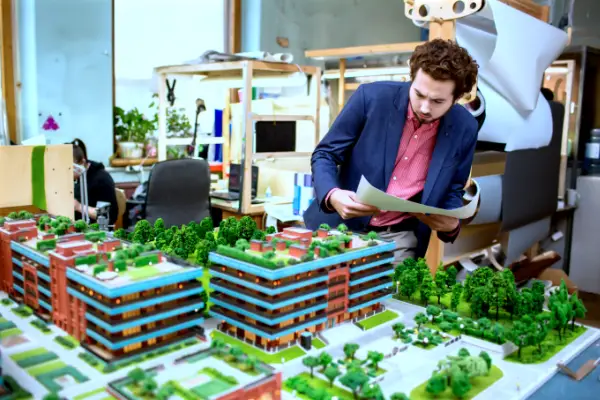
Integrating BIM in Landscape Architecture | BIM for Landscape
Don’t you think that landscape architecture stands as a testament to the seamless blend of nature and engineering artistry?
However, this field of architecture is becoming increasingly complex, forcing traditional methods to make a way for cutting-edge technologies. It’s because outdated methods do not cater to modern day requirements of enhanced precision, efficiency, and collaboration.
With the continuous evolution in this complex industry, BIM adoption is picking up the pace. In this article, you are going to learn how integrating BIM in landscape architecture is transforming the design process.
What is Landscape Architecture?
Steve Jobs rightly said that it is the technology married with liberal arts and humanities that yields us the results that make our hearts sing; landscape architecture is doing exactly the same.
The field that harmonizes outdoors environments with roads and buildings through design, planning, and management is called landscape architecture. It integrates art and science to create marvelous, sustainable, functional, and aesthetically pleasing environments.
The term entails a wide array of projects, including (but not limited to) gardens, urban parks, residential areas, commercial developments, campuses, public squares, greenways and natural reserves. All landscape architecture projects will entail elements of architecture, engineering, sociology, art, and environment.
Now that you acquired initial understanding of landscape architecture
Why Landscape Architecture Needs BIM?
Traditional methods such as 2D drawings lead to misinterpretations and errors during the implementation phases and errors or conflicts in this stage translates into cost overruns and delays. BIM resolve this issue by providing your teams access to 3D and data-rich environments that enhances and accuracy and collaboration.
If you belong to the old-school group and fear that adopting BIM means complete reinvention of today’s workflows, you are highly mistaken.
In fact, BIM amplifies the design process you already do, and it helps you make holistic, informed design decisions earlier in the process. What does that mean for your project? Identify and resolve conflicts in the design phase, avoid costly reworks, and increase profit margins.
Enhanced Visualization
One of the biggest advantages of the BIM over traditional method is that former gives your designer luxury of enhanced visualization. Using BIM, your design teams will be able to create highly detailed 3D models that will offer stakeholders a realistic representation of the landscape.
And if you want to give your client a clear and immersive view of the final design, you can harness power of virtual reality. This level of visualization will help your teams make informed decisions in the earlier stage of the project and reduce costly changes during construction. And being a business owner, what’s the biggest motivator than money for you?
Improved Collaboration and Communication
Another disadvantage of traditional methods is that they often ends up with discrepancies between the design intent and the final outcome. The reason? Miscommunication and poor collaboration. As a matter of fact, a study carried out by LetsBuild stated that the lack of standardized communication protocols lead to costly errors, delays, and even safety hazards.
BIM addresses this issue, too. When your architects, engineers, and contractors have access to a centralized model, communication gets streamlined automatically. Furthermore, any change that is made in BIM model is automatically updated across all the views. This enhanced collaboration and communication reduces likelihoods of errors and misunderstandings by making your design practice more efficient and cohesive.
If you are looking for the best information manager to manage, maintain, and share construction project information throughout the project lifecycle as per ISO 19650 standards, click here.
Sustainability and Environmental Impact
Sustainability is a key consideration in modern landscape architecture and you can harness the power of BIM to design sustainable landscapes. To do so, all you need to do is to integrate environmental data. By doing so, your teams will be able to analyze factors such as exposure, wind patterns, and water flow.
This way you can not only creates environmental friendly but also energy-efficient designs. Thus, BIM helps you meet the increasing demand for sustainable digital solution while establishing your practice as the champion of sustainability. You win trust of clients, public, and more projects.
BIM for Landscape Architecture – The DDC Way

If you want to make your next landscape project cost and time efficient through BIM adoption, look no further. Here at DDC Solutions, we are headed by one of the pioneering forces behind BIM, Jimi Clarke.
Unlike the conventional BIM-focused approach of merely ticking boxes with fancy acronyms, we customize our strategies to meet unique needs of your projects. We integrate with your teams to enhance your project’s efficiency, reduce costs, minimize waste, and improve risk management.
Our BIM consulting services stand out because of
Client-Centric Approach: Focus remains on achieving your project goals, not just ticking BIM compliance boxes. You get a bespoke BIM strategy to ensure maximum efficiency and cost-effectiveness.
Integrated Teamwork: We work alongside you as partners, not external consultants. Your projects directly benefit from our hands-on involvement, ensuring your unique requirements are fully met.
Bespoke Solutions: Every project is different, and so should be the BIM strategy. Therefore, we customize our technology and processes to support your specific goals.
Holistic Approach: From start to finish, we integrate BIM into every aspect of your project, helping you comply with stringent standards.
Customized Training: Your staff receives comprehensive training and support to use BIM tools and processes effectively, leading to significant reduction in errors and time waste.
So, book your free consultation today to embark on journey of BIM excellence that increases profits and improves risk management.

